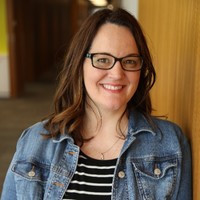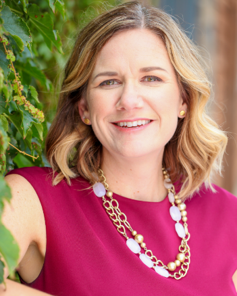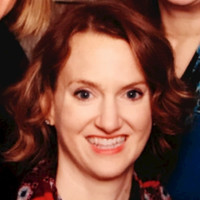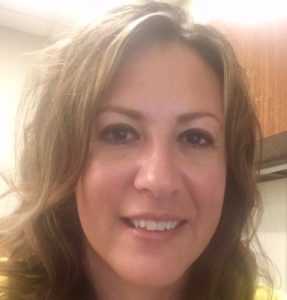
Our Healthcare Learning Leader Forum members wondered what current trends in healthcare learning professionals are most excited about and interested in implementing? To find out, we drew on some members of the forum to see what they’ve been exploring and implementing. Below, six experts share stories of various recent learning implementations using new-to-their-organization technologies, design approaches, and mindsets so you can learn from their experience.
Experiential Learning through Virtual Reality
Benedictine Health System
Few of us can imagine what the aging process will really be like, particularly if we find ourselves living with Alzheimer’s disease. Imagine sitting in a doctor’s office and being told you have failed the cognitive test, given a diagnosis, and then getting an inside look at the impact on your family. Now imagine the disease progressing and your losing the ability to perform everyday tasks like doing the dishes or showering.
A partnership with a virtual reality (VR) company, Embodied Labs, brought this opportunity to Benedictine Health System. Along with this came a new vision for the places experiential VR learning can be used and the impact it can have. The platform takes users through disease progression in true-to-life, realistic scenarios, including a field trip through the brain to see the disease and watch it progress over time. Additional experiential VR learning labs include living with macular degeneration, hearing loss, Lewy Body Dementia and a terminal diagnosis.
Benedictine Health System is still in a pilot phase, but the initial results are promising. Options like this are invaluable in a deeply-regulated industry with a high volume of traditional eLearning. There is work yet to do to understand how this can offset existing regulatory eLearning versus simply adding on this content and time for learners; however, the value and data improvement for caregivers around empathy, perspective, and learning are impressive to date. Learn more at www.bhshealth.org.
Simplifying Apheresis Center Training
 Carrie Jones, M.Ed
Carrie Jones, M.Ed
Performance & Learning Specialist | Be The Match
Advancements in cell and gene therapy mean lifesaving therapies are more available for cancer patients. While wonderful for patients and medical advancement, the increased demand for immunotherapies creates pressure on apheresis centers to deliver cellular starting material for these therapies. At any given time, one center can juggle anywhere from 5-30 external clinical, research, and commercial protocols – in addition to their internal day-to-day procedures.
Each of those external trials and protocols come with their own collection specifications and required training. The training is lengthy and not only covers unique specifications, but also routine processes that the centers regularly perform. The training also tends to include more information than necessary to perform the collection, contributing to cognitive overload. This leads to a loss in productivity and an increased risk of quality errors that could impact donor, patient, and/or product safety.
At Be The Match BioTherapies, we support these centers by partnering with them and our cell and gene therapy clients. From a training perspective, this allows us to simplify and be there for our centers while providing a level of service and confidence that each client demands for its protocol’s success.
For every client requiring starting material from an apheresis center, we assess and extract the “need to know” content from their protocol and collection manual. We then pop the information into a standard Articulāte Rise template that we use for each training. This template follows requirements for the FDA manufacturing process and simplifies the content through a design that fits the workflow of an apheresis center, including its cell therapy lab. Maintaining a consistent template enables the centers to know where to go for key information and saves them time because they don’t have to relearn a new format with each protocol.
At implementation, we deploy the module to the apheresis center two weeks before the first scheduled collection for a just-in-time training. All center staff assigned to the protocol must take the module, which should take no more than 10-15 minutes to complete and is tracked with our LMS. The module can also be used as a refresher for subsequent collections.
In addition, we schedule at least one Collection Support Meeting sometime during the week ahead of the first scheduled collection. This allows us to connect in person (or via Webex) to assess their readiness. During this meeting, we check for questions related to the module. We then walk them through a “happy path” collection scenario, with a focus on applying what they’ve learned to prepare the documentation and forms required before a product can be released for shipping to a manufacturer.
We’ll continue to adapt and adjust our approach as the demand for immunotherapies continues to grow. For now, the online training with a customized readiness check-in allows us to meet the needs of each center while meeting our clients’ expectations for consistent delivery of their unique specifications. This in turn provides more time for everyone to focus on saving lives.
New Hire Training at Blue Cross MN
 Karl Noot
Karl Noot
Learning Consultant | Blue Cross MN
We all spend a lot of time thinking about how people learn. Applying what we know about learning and design is a fun and creative way to keep fresh and involved in solving learning problems.
We recently faced a course design challenge in our customer service new hire course. We were interested in finding a new way to efficiently provide a better new hire training experience to the customer service employees who answer member questions on the phone. Like many companies, we historically used the standard instructor-led training (ILT) approach. Learner and instructor feedback from this course has been mixed over the years, with many concerned about how long training was before they talked to a member and how difficult it was to remember everything learned over an eight-week course.
In response, we designed a blended learning approach that chunked the content of our new hire class content into three phases. We introduce basic company-specific topics and how to respond to five specific call types in Phase 1. This is delivered through eLearning courses, ILT, videos of live calls, spaced repetition quizzes, and practice opportunities. Then learners begin answering live member calls specific to what they know within two weeks of hire.
We use this same pattern for Phases 2 and 3. We present a new chunk of slightly more complex content in each phase, during which the learners have practice opportunities in class, and then they answer live member calls to practice what they learned.
We’ve almost completed our second pilot, and we have been quite pleased with the results. The content has been chunked and made easier to digest, and probably most importantly, . All these improvements have helped learners to be more comfortable and better equipped to answer member questions right out of class.
Healthcare Learning Trends and Applied Solutions at Medtronic
Michelle Casper
Principal Training Specialist | Medtronic
It’s an exciting time to be in the healthcare industry where huge technological advances seem to occur at an increasing rate and help a greater number of people lead healthier, longer lives. Much of the recent innovation in medical technology has resulted in devices getting smaller and tools and procedures becoming even less invasive.
I think a parallel could be drawn between advances in healthcare technology and our learning strategy in the healthcare industry. While our medical technologies shrink in size, so too is our approach to training our workforce. With over 90,000 learners around the world, each minute that an employee is away from work for training or eLearning is a significant cost to our company.
As learning professionals, we have a duty to maximize the return on the investment in employee time. In our department, we strive to make our content efficient and concise, but also effective and accessible for our learners. In a sense, our goal is to design and deliver training that is minimally invasive to our employee base.
To achieve this goal, we are designing courses that are shorter and simpler than in previous years. We are not yet at the microlearning level, but we are definitely heading in the direction of small and mighty.
From a tools perspective, we are looking for more ways to incorporate video into our learning solutions – video both from a camera and via animation tools. Video communicates a lot more in less time than static text and pictures. We see video as a tool to minimize seat time and maximize attention and retention.
Lastly, a large part of our workforce is in the field interacting with customers. They are often on the road and need to complete their required eLearning courses in between customer visits. For our field personnel, eLearning that is mobile-friendly is critical, as is a short, effective course design.
Expanding the Definition of Development
 Hannah Peterson
Hannah Peterson
Director, Organizational Development & Learning | Fairview Health Services
At Fairview, we are working to broaden the definition of development to help everyone engage in improving professionally and personally. We want people to recognize development opportunities in their daily work. For example, in small things like sharing their expertise with a peer in the moment; and larger ways, like taking a role in a new function.
Two examples of the work we’re doing to build this development mindset with our team members are requiring a development-focused goal each year and creating a casual facilitator program.
In 2019, we have an organizational goal that 100% of our 33,000+ employees have a development-based goal. By asking everyone to think about a way they want to grow, we put their development in their hands. Expecting a development goal was new in 2019 and our focus is to get people comfortable with a broad concept of development and understanding that it can be anything that builds on strengths, improves “weaknesses,” builds mastery, or teaches something new.
Our second example is the introduction of a casual facilitator program. We’re taking healthcare’s concept of “casual” employees and offering front-line team members and leaders opportunities to develop presentation and facilitation skills by leading core OD&L programs on a part-time basis. For example, a nurse will be able to teach one 2-hour class a month.
As we work to build a development mindset across our organization and advance employees’ knowledge, skills, and behaviors, we believe we can differentiate ourselves as an employer and as a healthcare system.
Ready, Set, Practice!
Gabriella Broady
Global Director, Sales Learning & Development Medical Division | Cantel
As a learning leader, how do you go about creating effective, application-based learning experiences for a medical device sales team that a) is geographically dispersed, and b) requires hands-on training on large medical devices, software, etc., typically done in hotel conference rooms? These are two challenges we face in our organization due to rapid growth that has superseded the size of our training rooms. It is critical that the sales team is well-equipped with the latest clinical information and product knowledge to best serve as partners in infection prevention with our customers. Here are two strategies we’ve executed that have served our salesforce well:
Rehearsal: A video-based coaching tool allows reps to practice new sales scenarios by recording and submitting video of themselves through their computer or mobile and get video-based coaching feedback from a mentor – with trackable results. This is an excellent post-training reinforcement tool when , or for individualized learning plans for reps needing more coaching in an area. Additionally, rehearsal allows for “push” content; we’ve used this functionality to drive peer sharing – such as videos on best practices and product demonstrations. This allows reps “one-stop” access to content they can watch as often as needed. (www.rehearsal.com)
Simulation exercises: While we’re not yet able to launch augmented reality-based training, we have created “room backdrops” that are set up around a training room, depicting real-life customer workflows as they use the products . Barcodes placed on the products and use of scanners and a monitor in each “room” allowed learners to simulate a customer’s hands-free reprocessing workflow and see real-time data captured in the software as it changed on the monitor. This is much easier, more effective, and more economical than shipping equipment to create the “room” layout, or showing static screenshots via PowerPoint.
Learning strategies that enable teams to practice, get personalized feedback, and immerse themselves as much as possible in “real-life” situations are critical in the healthcare industry. After all, the ultimate end goal is to minimize risk to patients and staff while providing excellent care.



